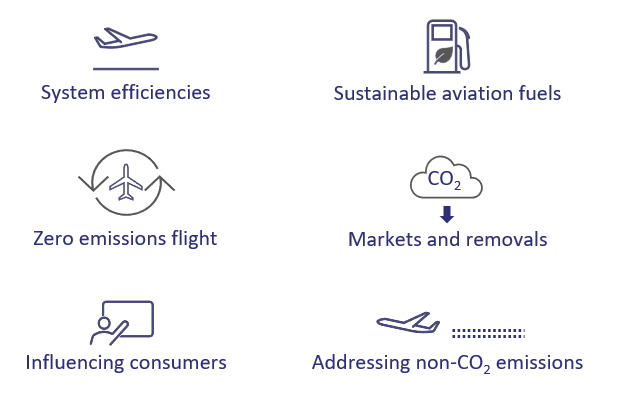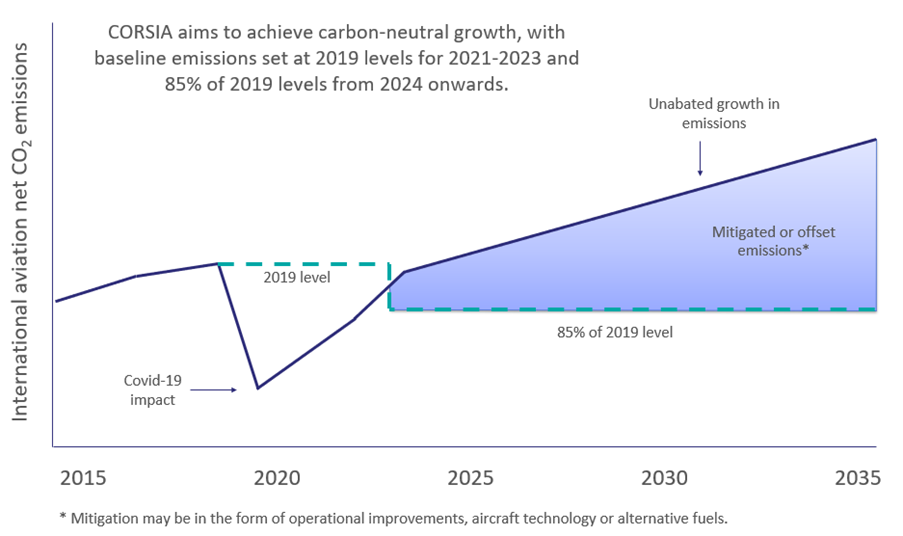Sustainable aviation policy landscape: an overview
Overview
Making sense of the fast-moving and complex policy landscape can be a daunting task, particularly for SMEs and new entrants to the aerospace sector. An awareness of the policy landscape, including ongoing initiatives, emerging support, and the long-term aspirations for the sector can help organisations understand how their activities can contribute to the industry’s transition towards Net Zero, and the business opportunities that could be generated along the way.
While not exhaustive, this overview will provide a glance at the key pieces of legislation, focusing on the UK, but also touching on that of the EU, US and the wider international context, to explain the converging and diverging policy landscape. Links have been provided in the headings for each policy measure should you wish to find out more.
The funding landscape is a key element of policy which can provide R&D support to the aerospace sector to help achieve decarbonisation. An overview of this is provided separately here. Also published on the ATI Hub is an introduction to the UK Civil Aviation Authority (CAA), covering their regulatory role in aviation.
This resource was updated in June 2024.
Please note the ATI is not responsible for the content provided in the links to third party websites included in this resource.
UK policy
The UK’s air transport sector is making progress towards Net Zero through collaborative working and partnerships between government and industry. A combination of voluntary measures and regulatory developments, guided by scientific understanding and industry advice is helping to build a strong landscape in which investment and technological development can thrive. While more needs to be done to accelerate the transition, this framework allows organisations to contribute to the direction of UK policy and align business priorities with national objectives.
In 2019 the UK government committed to a 100% reduction in greenhouse gas emissions by 2050, referred to as the Net Zero target. This was made legally binding by the Climate Change Act 2008 (2050 Target Amendment) Order 2019. Soon after establishing this target, interim targets were also set to reduce carbon emissions by 68% by 2030 compared to 1990 levels, and 77% by 2035. Alongside these commitments, carbon budgets have been put in place, restricting the total amount of greenhouse gases the UK can emit. These have been legislated over 5-year periods, currently up to 2037. While domestic aviation has been included in all carbon budgets, emissions from international aviation were only introduced in the sixth carbon budget spanning 2033-2037.
The policy measures outlined below detail measures the government has taken to progress towards achieving these targets.
EU policy
The EU has committed to achieving a 55% reduction in emissions by 2030 compared to 1990 levels, and climate neutrality by 2050. This commitment is supported by member states and is also reflected in commitments and action across the aerospace industry. Policy support mechanisms and regulatory drivers are in place to accelerate this transition and continue to evolve. Despite the make-up of the EU slowing the development and emergence of policy, the EU is still often considered a global leader in the Net Zero transition.
US policy
The US policy landscape is made up of national and state legislation, the majority of which is in place to incentivise rather than mandate change. Since rejoining the Paris Agreement in 2021, the US has been ramping up its commitment and action to decarbonise. It is committed to reducing greenhouse gas emissions to 50-52% below 2005 levels by 2030 and achieving Net Zero by 2050.
International policy
International policy and standards have emerged from the International Civil Aviation Organisation (ICAO) to facilitate cooperation amongst member states and help achieve cohesive global air mobility. This is likely to become increasingly important over the coming decades as new, sustainable fuels and technologies need to be rolled out in a timely way to address the impact of aviation’s greenhouse gas emissions.
Further support from the ATI
We hope that this resource has provided a useful overview of the policy landscape, both in the UK and internationally, and has helped you to understand the policy landscape that forms the framework for the industry’s transition to Net Zero. To find out more about the sustainable aviation policy landscape, please follow the links embedded throughout this page or get in touch.
How the ATI Hub can help you
A good place to start is one of our monthly Meet the ATI sessions, where you can talk to us about how the ATI might be able to support your company. To find out more about the wider funding landscape, to give us feedback, or for any questions about the ATI Hub, please get in touch!

